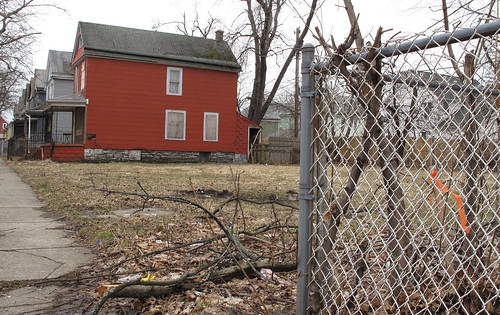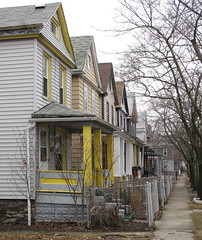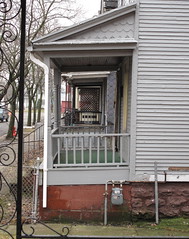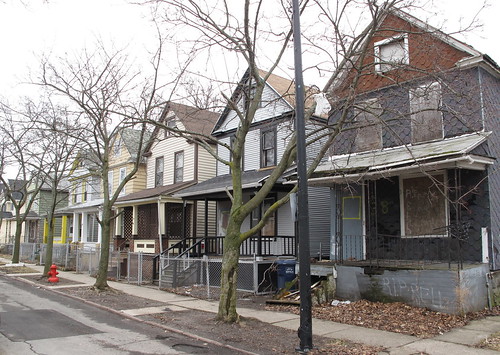I took a closer look at Belmont Shelter's Neighborhood Plan and walked over to Ada Place the other day. Standing at the north end of Ada - first pic below - I noticed that Belmont Shelter has staked out plans for the first house. According to their plan three existing lots will be combined into one at 50, 52 and 54 Ada.
The houses on Ada Place, one of the most compact streetscapes in Buffalo, are often a stunningly narrow 14' feet in width on 21' wide lots. The uniqueness of this urban scene is its most compelling economic resource - something which appears to be ignored entirely by Belmont Shelter and its City sponsors. Perhaps the only corollary to Ada Place is Coe Place, adjacent to Artspace, where a very similar compact block is gradually being rehabbed by home owners who recognize the value of its colorful, compact, urban character. The same could happen on Ada Place - that is, if more of its delapidated and high potential historic properties are saved and silly suburban houses do not replace them or destroy its interesting character. Currently, six of these houses are abandoned, boarded and vacant - ready for rehab.
Where's the vision? Rather than reinforcing good urban design principles and strengthening the neighborhood, we settle for less - again. Why?
__________________________________________________________________________The houses on Ada Place, one of the most compact streetscapes in Buffalo, are often a stunningly narrow 14' feet in width on 21' wide lots. The uniqueness of this urban scene is its most compelling economic resource - something which appears to be ignored entirely by Belmont Shelter and its City sponsors. Perhaps the only corollary to Ada Place is Coe Place, adjacent to Artspace, where a very similar compact block is gradually being rehabbed by home owners who recognize the value of its colorful, compact, urban character. The same could happen on Ada Place - that is, if more of its delapidated and high potential historic properties are saved and silly suburban houses do not replace them or destroy its interesting character. Currently, six of these houses are abandoned, boarded and vacant - ready for rehab.
Ada Place - click image to enlarge
Belmont is assembling over 100 lots from the City and plans to build 49 new rental houses and a 'clubhouse' - on Michigan, near Best Street - as part of their new neighborhood plan. The consequence here is that the neighborhood's former density will be damaged. The potential advantage of maximizing our earlier half-billion dollar investment in light rail rapid transit is not reinforced. Advocating and developing a market for lower density, 'suburban style' and car friendly design is exactly not what was intended when the City's subway was built.Where's the vision? Rather than reinforcing good urban design principles and strengthening the neighborhood, we settle for less - again. Why?
Artspace • BAVPA • Woodlawn Row Houses • fixBuffalo flickr
Creative Class • Shrinking Cities • Saturdays in the neighborhood






10 comments:
Good post. Consider how much better the neighborhood would be if these resources were invested in rehabbing these historic properties rather than creating a poor facsimile of Alden on Ada Place.
And a club house? What is this? The Orchard Park Country Club? How about sufficient density to sustain a good corner store? How about that for a community gathering place? Where is the understanding of urbanism in these developments?
I recently discovered Ada Place... it is one of the most charming streets in the city.
Susan asks good questions that are rhetorical for those of us who like "urban". The people that conceive and implement these projects either don't like urban, don't care or don't know why it matters.
-Jeff B.
Here is a question that I will never get an answer to: How many of the people who dreamed up this proposal are even residents of the city? Not that you can't like or care for the city while living outside of it but why is it that we must build so scatter-shot and then make it look like every suburb in America? In my opinion it is because most have given up on Buffalo as a place that matters. And then there is the painful truth that any new builds in Buffalo only speed the demise of other houses in the city.
A corolary also might be Union Pl and Little Summer. The scant lot size and diminutive living spaces sure have made that area popular. But it is probably assumed by "housing agencies" that every place to live in Buffalo that gets built or rehabbed needs to be suburban-esque because "that's what people want". Sure, people will take that if that is all you are offering but many people will like urban if you give them a newly restored urban abode.
Belmont (and City Officials) are sure doing their best to minimize the goodwill their projects could have. All respect and appreciation I had gained for Belmont based on their rehab of the Ward House on Coe is lost. One good project can't make up for dozens of ill-conceived ones.
This streetscape is indeed adorably dense; take a "stroll" via Google's Street View here http://tinyurl.com/dl23xf.
Also worth noticing: it is possible to create an effective tree canopy over the street with smaller, younger trees when the right-of-way is narrower.
Last point: Belmont eventually saw the light on Coe Pl. David, is there anything we can do to build upon your success over there? Maybe, if they recognized the charms of Coe, they could recognize the charms of Ada as well?
To play devil's advocate a bit, perhaps high density is simply not feasible. Urban density occurs for many complex reasons, one of which is demand (driven by a large population) for a fixed supply of land. One of the city's many problems has been a drastically shrinking population (down over 50% from it's peak in the 50's[1]). This massive shrinkage of both the population and tax base has driven down demand for urban housing so low that even if you were to fix up all these properties, whats to say that you could fill them?
Some people may find a 14' wide house attractive, but given the choice between that and "normal" row house (or even a suburban house) 95% of the population would elect for the latter.
We all want to see Buffalo be a thriving city some day, but we all have different approaches and different priorities. For myself (and I'm guessing Belmont Shelter as well) simply getting some fresh blood into the city ranks higher then preserving old buildings.
Suburban style homes aren't ideal, I'll happily agree, but if that's what it takes to get positive population growth then I'll support it. To be honest, Buffalo should be so be so lucky as to have too many people trying to live inside the city limits.
[1] http://en.wikipedia.org/wiki/Buffalo,_New_York
That said, I'm new to the area and have no formal education in urban planning, so please take this as a personal opinion and not any pretense to authority. If you disagree, I would love to hear why.
To understand Belmont's "plan" for the city you need look no further than the character of the office building.
Levvy,
Sprawl, weather in the city or in the suburbs, has been and continues to be one of the biggest dangers to our country and society. We can not continue to perpetuate a system of waste and environmental destruction the way we do.
People enjoy high quality dense active neighborhoods when they are provided with them. Not everyone has the urge to live is a banal suburban environment.
Levy,
Density is happening in this neighborhood. Belmont is the property manager of the new Artspace nearby. Down the street the Packard Apts will be opening later this spring. Both of these developments involve the carefully planned reuse of existing structures.
You're right about new people. We need them. The issue with new builds is that the preliminary data that I've collected shows that people who are moving into these new builds already live in the City and are simply trading up. This is the case with the new Sycamore Village. The first 6 sales involve people who already live here, despite the marketing campaign by the the Brown Administration that this new development would attract suburban families that desired an urban setting.
What ends up happening is similar to the game of musical chairs. In a City that is losing 50 people/week, new builds are traded for the old - which often end up going vacant and eventually are trucked off to a landfill.
What's presented as a dense new development in this particular case involving Belmont is anything but. By combining lots and building 'suburban style' houses in the city we strip the longer term potential of creating the dense thriving urbanity that creates a vibrant city.
Back to my point. Why settle?
The high cost of these houses is because Belmont's closely-held for-profit sister companies need to make profits for their owners, which include Belmont's top administration and some board members.
See p. 18 of http://www.guidestar.org/FinDocuments/2004/161/080/2004-161080227-01f840fe-9.pdf for a list of some of those companies. There are other closely-held construction companies not listed here that do work for Belmont too.
Also they are probably realizing heavy losses on their retirement investments in Altria, GM, GMAC, etc... listed on p. 16 of the same document and are under financial pressure to make some big money back. 50 houses @ $240,000 x 15% profit = $1.8 Million in profits tto go around.
Most of the blame for the planning of these houses lies with the City though, as there is no housing plan for this section of the City.
By the way, could you look into the housing court status of the Belmont building at the corner of Coe and Main, next to Artspace? It's been vacant and an eyesore since Artspace began.
Levvy,
Point well taken... I sympathize with the logic that since we have so much space or decaying buildings that will soon be open space, why bother building dense at all.
But instead, I would like to see complete abandonment of some sections of the city in order to concentrate wealth/people in smaller vibrant areas instead of this 100 year transformation of much of Buffalo into a cheap and unattractive looking version of suburbia. Make no mistake, everywhere new homes are built still doesn't look as attractive as any suburb. And it is taxpayer subsidized to entice people. Then the trickle-down/musical chairs effect ends in more homes in Buffalo being abandoned and torn down at taxpayers expense since the population continues to decline while we build more housing. I hate the new construction but if I can't stop it, I will badger for it to stop turning the urban look and feel into suburban ghetto. And down the road, many of us including plenty of respected national experts believe there will be an urban boom (for reasons that are too long to get into here). If and when that happens, everywhere the urban streetscape has been lost and isn't an attraction for those seeking urban built environment, the area will not experience that boom/rebirth. In modern history, ciy design has been what drew people back to cities, not the "somewhere is nowhere is everywhere" of suburban look and feel. As Chris Hawley has said, respecting existing lot lines and setbacks is all it takes. You can still have your driveway w/ garage in rear in many places. There are plenty of newly built communities around the country that are eminating city values in built environment - see New Urbanist or Walkable Communities. Collectively, we just don't aspire to anything but mediocrity here.
Jeff B.
Levvy,
The use of suburban style homes on lots such as these in this part of the city is simply contrary to the purpose of a city. The HEART of urbanity is denseness, public life, and choice. Good, thriving cities have critical mass of people, who are within efficient walking distance of 90% of their daily uses. This gets people on the sidewalks (public life), which contributes to safety, liveliness, and interest. This high density pedestrian traffic is what supports corner stores and local businesses (and having enough people to support two of each of these businesses provides choice, and choice breeds desirability).
These are the principles that have been the backbone of Elmwood Ave. Density, diversity, public life, and choice. And anyone living there would KILL you if you tried to build this ill-fitting suburban house on no less than THREE prime lots, which with a better design could house up to SIX families instead of ONE.
Belmont shelter, through design alone, is dooming this neighborhood to further decay, because they are interrupting established design patterns and installing patterns that CANNOT conform to this urban matrix. The patterns of public life that kept these houses safe, the sidewalks interesting, and the neighborhood anchored are being obliterated by these incompatible, ridiculously buffered, expensive, subsidized homes.
They should be building new, attractive, two family dwellings that cater to low income, but that through DESIGN alone, can prevent low income from also meaning "dangerous, dirty, overcrowded, uninteresting, disconnected, etc."
This house puts one family on a parcel that used to support six. It has a useless porch, and a useless front yard. Half the facade is devoted to the garage door, when many low income families don't have a car. It is set back far enough to create a "gray area;" a dead space that offers safety neither for the homeowner nor the pedestrian, and as such neither can add to the public life of the other. Suburban layouts are not equipped to handles the demands of functional urban matrices, which are complex.
The East Side may have lost these fantastic elements of city living, but Belmont Shelter is guaranteeing they will never come back.
Unfortunately, part of what contributed to urban density 100 years ago was the present of large families crammed into too small living spaces. Several children in each bedroom or bed. Boarders, sometimes family, sometimes not, and extra rooms to let for rent added on to the back of the house. Read the 1890 Buffalo City Directory. Also, houses so close together they were a fire hazard, because they were built in the 1870s and 1880s only far enough apart to walk your horse to the barn in the back. People today want their own rooms, one for each child, and more rooms for the family. Who would live in a house 14 feet wide? Perhaps those houses would compete with the market for mobile homes. Today, it would be rare to find tenants who have more than one otheer person living with them to move into a house 14 feet wide. Perhaps a starter house for a newly married couple or a house for a single person. I don't think there are enough jobs to support large numbers of immigrant families like 100 years ago that might be willing to live that densely packed. Perhaps they could built good townhomes to replace the missing ones, but one big overpriced suburban house stapled together with waferboard and covered with vinyl will just add to the ghetto.
Post a Comment